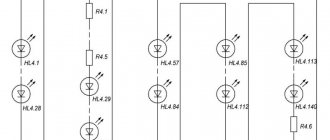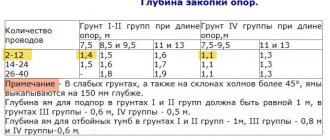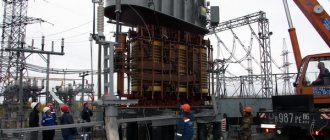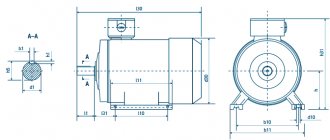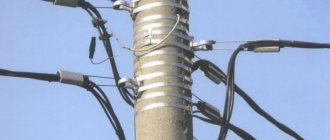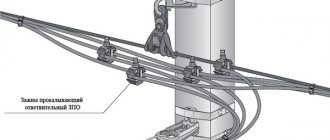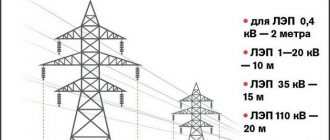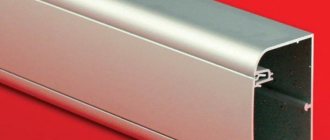The condition of power lines is significantly influenced by the type of supports used. For 100 years, the wooden support remained one of the main structures of overhead lines (OL).
Only in the 60s of the last century they began to make it with protective impregnation. At that time, instructions were given on the use of antiseptics, but they were poorly implemented, which led to rotting of the supports. The widespread transition to reinforced concrete pillars did not solve all the problems, since they showed disadvantages that are not inherent in wood products:
- fragility upon impact;
- low bending strength;
- significant weight;
- presence of leakage currents.
Advantages
Wooden support will never be written off due to the following advantages:
- Low cost.
- Light weight.
- When a wooden pole falls, the weight of which is 3 times less than a reinforced concrete one, it hangs on the wires without the “domino” effect characteristic of heavy poles.
- Indispensable in areas with increased seismic activity.
- Better withstand wind loads.
- High dielectric characteristics.
- Long service life if properly manufactured (up to 40 years).
- Do not require special maintenance.
Flaws
Along with the advantages, wooden supports have disadvantages.
- Impregnating compositions may contain harmful substances that are in the air of the work area (fuel oil, kerosene, creosote, etc.). Oil-based antiseptics are especially harmful. In addition, they have an increased fire hazard.
- Logs must be manufactured with the required diameters and taper.
- High-quality products are obtained by winter cutting and drying under a canopy for 6 months. Here it is necessary to treat the logs with an antiseptic so that they do not rot.
Quality control
During the manufacturing process, supports undergo several stages of quality control. The first involves examining an element of a future power line for geometric accuracy. After this, the workpiece is sent for drying. Before impregnation, the material is checked for moisture content, which should not exceed 28%. Next, control verification activities are provided, during which the characteristics of the protective agent used to treat wooden power line poles are determined. Installation rules require that the material be delivered to the installation site with an optimally impregnated structure. To comply with this condition, technologists evaluate the depth of impregnation, and based on the results of the analysis, an appropriate quality certificate is generated.
Materials
Wooden power line supports are made from coniferous trees, where the resin is a natural preservative and antiseptic. Northern pine, which has high strength and elasticity, is in greatest demand. The problems that reinforced concrete pillars have due to their fragility are never created by wooden supports (photo below - loading of finished products).
For impregnation, shale or creosote oil is used, as well as mixtures containing copper, chromium, and arsenic. Additionally, the supports are treated with antiseptic agents (fire retardants). This allows the pillars to be buried directly into the ground, without concrete steps, which increases their service life.
Products made from pine have the highest absorbency. If spruce and larch are used for supports, it is much more difficult to saturate them.
Impregnation allows you to bury the pillars directly into the ground. Only here it is necessary to additionally protect the ends with protective paste or covers. It is important to dry the wooden support for up to 3 months before impregnation. Fastening to reinforced concrete supports leads to splitting of the wood under the wire rod bands.
Important! To make pillars, use the lower part of the tree (butt), where there are fewer branches and a more uniform structure.
Types of electric poles
Today you can find power poles from:
- metal;
Metal support
- reinforced concrete;
Reinforced concrete support
- tree.
Wooden homemade support
Metal supports are most often used for high-voltage lines because only a metal structure can support the enormous weight of wires and insulators.
Reinforced concrete pillars are most often found on damp and soft soil, where the metal corrodes and the wood simply rots.
Wooden poles are the cheapest compared to other types, and their installation is much simpler; such a pole can be installed without the help of special equipment and specialists.
Criteria for choosing a wooden support
- The material used is northern winter-cut pine.
- At the top of the column the thickness is at least 16 cm.
- An aqueous solution of SSA is used as impregnation.
- The entire support or the lower part is impregnated at the factory under a pressure of 12-14 atm.
- Technological holes are made before impregnation.
- The depth of impregnation is 85% of the outer layer of wood - sapwood (up to 40 mm).
- The impregnation process is complete if the color of the support is gray-green. If it is brown or brown, this means that the reaction is not complete. The border should be visible on the cut of the log.
- The supports are sold in classes C1 and C3 with a complete set of sizes.
Features of impregnation of supports
The pillars are installed in the ground without stepsons. The ends are soaked more than the side surface. During operation, up to 90% of the protective composition is washed out of them. To prevent this, the top end is covered with a galvanized roof measuring 250x250 mm, and the bottom is covered with a flat material that does not allow moisture to pass through.
According to GOST 20022.0-93, the wood for supports is impregnated with the protective agent XM-11 in terms of dry salt in an amount of 13-15 kg/m3. When purchasing logs for poles, you should find out under what conditions they were made, since in some specifications this quantity is underestimated by 2 times. Not all manufacturers correctly follow the manufacturing technology of their products. This requires the organization of quality control, although a specialist can determine it visually.
Terms and Definitions
The following terms with corresponding definitions are used in this standard:
3.1. Impregnation depth is the thickness of the wood layer containing the protective agent.
3.2. Sapwood is the outer, lying directly under the bark, mostly light-colored, zone of wood of trunks and branches, physiologically active in a growing tree.
3.3. Buttiness is a sharp increase in the diameter of the butt part of round timber or the width of unedged lumber, when the diameter (width) of the butt end is at least 1.2 times greater than the diameter (width) of the assortment, measured at a distance of 1 m from this end.
3.4. A healthy knot is a knot that has wood without rot.
3.5. Curvature is the deviation of the longitudinal axis of the support from a straight line, due to the curvature of the trunk.
3.6. Mechanical damage - nicks, cuts, chips, flakes, tears, as well as open sprouts, dry sides and cancer.
3.7. Overhead line support is a structure designed to hold wires, lightning protection cables of overhead power lines, as well as communication lines at a certain distance from each other and from the surface of the earth.
5
3.8. Wood impregnation is the introduction of protective agents into wood that preserve and improve its properties.
3.9. Antiseptic absorption is the amount of antiseptic introduced per unit volume of wood during impregnation.
3.10. Pre-impregnation wood moisture content - wood moisture content determined before impregnation in accordance with GOST 20022.14-84.
3.11. Simple curvature is a curvature characterized by only one bend in one plane of support.
3.12. An overgrowth is an overgrown or overgrown wound, accompanied by a radial slit-like cavity, usually filled with remnants of bark and dead tissue.
3.13. Ribbed butt is a butt with a star-shaped cross-section of round timber.
3.14. Tapering is a gradual decrease in the diameter of round timber or the width of unedged lumber throughout its entire length, exceeding the normal taper equal to 1 cm per 1 m of length of the assortment.
3.15. Complex curvature is a curvature characterized by two or more bends in one or more planes of support.
3.16. A knot is a part of a branch enclosed in the wood of a support.
3.17. Tobacco knot is a rotten or rotten knot in which the wood has completely or partially turned into a loose mass of rusty brown (tobacco) or whitish color.
3.18. A crack is a break in wood along the grain.
3.19. Hard to wash out (antiseptic) - an antiseptic that chemically bonds with wood to form new water-insoluble compounds.
3.20. Fixation of a protective agent in wood is the transition of water-soluble protective agents in wood to an insoluble state.
3.21. Wormhole - passages and holes made in wood by insects.
debarking
The bark and phloem are removed using a specialized machine. Only after this the trunk begins to dry. Sapwood should be touched to a minimum, since it is this wood that is well saturated with an antiseptic. If the entire top layer is cut off, the durability of the support will be greatly reduced due to the fact that it will be more susceptible to rotting. Then the wooden support, the dimensions of which meet the requirements, is sorted according to its intended purpose. Some manufacturers dry the wood without removing the bast, which makes it possible to prevent cracking of the wood. Then the bast is removed, as it will interfere with the impregnation process.
Overhead line supports
The installation of wooden supports is carried out on class 3 overhead lines, where the rated operating voltage is 1 kV or less. The most common are intermediate supports that serve to support wires. In addition, they perceive wind loads, as well as the weight of the reinforcement and their own. On their own, they may not be able to withstand the forces generated along the line if a break occurs. This load is perceived by anchor supports with additional struts located along the axis of the overhead line. They mainly serve to create tension on a section of wires. To absorb lateral loads, anchor supports are used with struts or “legs” located in a perpendicular direction.
There are also corner supports that absorb longitudinal and lateral loads. They are installed to turn lines.
Installation of wooden supports is carried out with precise markings of places, and assembly is carried out with a tight fit of parts.
The gap where the cuts are made should not be more than 4 mm. The interfaces are tightly fitted. The holes are drilled.
Maintenance and repair of wooden poles
Wooden power line supports are subject to periodic inspections and repairs. In the summer, at a depth of 30-50 cm, the depth of wood decay is checked. If the diameter of the log is 25 cm and there is more than 3 cm of rot, it is considered unsuitable and must be replaced.
Major repairs of lines, where mostly wooden supports are installed, are done at least every 6 years. The remaining repair work is carried out within a time frame depending on available resources.
The fire hazard of wooden supports requires labor-intensive operations to reduce it. If there are wooden attachments around, a ditch 0.4 m deep is dug and grass and bushes are removed.
Parts from the supports are replaced with new ones while the line is running. Here it is necessary to take into account that on parts of the structure the loads may exceed the design ones.
If the poles have deviated from the vertical by an unacceptable amount, additional loads may cause the wires to change position and get caught or touch parts. Displacements occur due to weakening of the foundation or sealing of the base of the support, displacement of the soil, weakening of connections.
Alignment is carried out using steel cables attached to a stand. The base is dug to a depth of 1.5 m and the support is straightened using a traction mechanism. Then the pit is filled and compacted.
When the stand warps due to a loose connection with the bandage, it is straightened without displacing the stepsons.
A bandage is installed on the rotted rack. Before this, the rot is removed and the pillar is covered with antiseptic paste.
Damaged parts are reinforced with temporary overlays made of wood or metal, using half-clamps, bolts and banding wire.
Before being transported to the track, parts are checked for compliance with design parameters.
To increase the service life of the racks, they should be additionally impregnated during operation by diffusion. Antiseptic bandages are installed on the underground and above-ground parts of the support and on the joints. Antiseptic paste is applied into cracks and on the tops of racks with attachments.
Due to the fact that the mass of the wooden support is small, heavy equipment is rarely required for repairs.
The support that cannot be repaired is freed from all loads and replaced with a new one using special equipment.
Installation of wooden poles
Any support, be it a fence post or an electric pole, must be thoroughly strengthened in the ground, for which we need a cement solution. Let's look at how to install a wooden electric pole with your own hands.
Following foreign experience, for power lines with a voltage not exceeding 10 kilowatts, it is best to install impregnated wooden supports.
- There is no need to mark the territory, if the pillar is a single copy, you can simply “by eye” calculate the location and remove the top layer of soil, no deeper than 20 centimeters.
- We drill a hole. To do this, you can use a brace or a garden drill. The depth of the hole should be at least two meters, and the diameter should be 20-25 centimeters wider than the post.
- We install the post into the hole to its full depth in a strictly vertical position (check with a vertical level).
- Holding the post (you can’t do this without helpers), we lay a reinforcing mesh harness around the post.
- Fill it with concrete.
- Now you need to wait a week for the concrete to harden, checking every day to make sure the pole is not sagging.
There is an option for installing a pillar without concreting, but it is much more complicated, because every 20 centimeters of the hole must be carefully compacted when filling, a process that requires a lot of labor and time.
Holes without concreting should be filled with crushed stone or gravel, which will force you to spend additional money on purchase and delivery, which costs several times more than the crushed stone itself.
Important! While the concrete has not “set”, you can make supports for the post so that it does not begin to tilt. To do this, you can stretch reinforcing or steel wire on three sides, attached to metal pegs driven into the ground.


